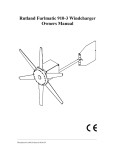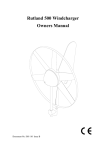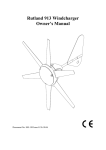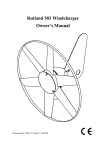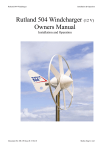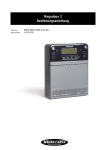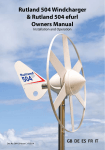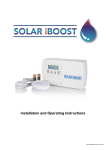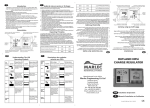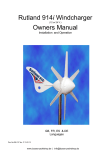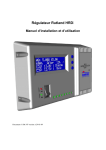Download Rutland Furlmatic 910-3 Windcharger Owners Manual
Transcript
Rutland Furlmatic 910-3 Windcharger Owners Manual _________________________________________________________________________________________ _ Document No: SM124 Issue C 05.11.03 Marlec Eng Co Ltd Installation Instructions Page INTRODUCTION……………………………………………………. 2 GENERAL GUIDELINES & WARNINGS………………………….. 2 CHECK YOU HAVE RECEIVED…………………………………… 4 WHAT YOU WILL NEED…………………………………………… 4 SITING THE WINDCHARGER…………………………………….. 5 PRINCIPLE OF OPERATION………………………………………. 6 TOWER CONSTRUCTION…………………………………………. 7 ASSEMBLY & INSTALLATION…………………………………… 8 Blade Assembly…………………………………. 8 Furlmatic Tail Assembly………………………… 9 BATTERIES…………………………………………………………. 10 CABLE SPECIFICATION…………………………………………… 11 ELECTRICAL CONNECTION……………………………………… 11 HOW TO ASSEMBLE THE IN-LINE FUSE HOLDER…………... 12 BASIC WIRING DIAGRAMS………………………………………. 13 FITTING GENERATOR TO THE TOWER………………………… 14 Final Mechanical check…………………………. 14 UP AND RUNNING………………………………………………… 15 SPECIFICATION AND PERFORMANCE………………………… 15 INSPECTION AND MAINTENANCE…………………………….. 16 TROUBLESHOOTING…………………………………………….. 17 _________________________________________________________________________________________ _ Document No: SM124 Issue C 05.11.03 1 Marlec Eng Co Ltd Installation Instructions INTRODUCTION This manual contains important information concerning your Rutland 913 Windcharger and its installation and operation. It is strongly recommended that you read this manual and familiarise yourself with its contents before installing and operating the Windcharger system. The Rutland 913 Windcharger is designed to provide a direct current (DC) power supply via a battery bank for 12/24V equipment, lighting, etc. It is robustly constructed and designed to give many years of trouble free service with the minimum of maintenance. Please take notice of our General Guidelines for the user and Inspection and Maintenance sections. GENERAL GUIDELINES & WARNINGS! • Observe the mounting pole diameters recommended in this manua!. It is essential to the effective operation of the furling tail system that the mounting pole is vertical. An unsupported tower will experience lateral movement particularly in high winds and furling will be adversely affected will potential damage to the wind turbine. • When turning, the Windcharger is capable of generating voltages in excess of the nominal voltage. The turbine must never be allowed to rotate unless it is electrically connected to a regulator or batteries. Avoid applying a short circuit to the windcharger particularly in high winds. If a short circuit is necessary first slow the turbine as described below. Caution must be exercised at all times to avoid electric shock. • Stopping the turbine – this may be necessary to undertake battery maintenance. If possible stopping the turbine should be done in low windspeed conditions. The turbine can be slowed by rotating or orienting the tail fin upwind, this will slow the turbine sufficiently for it to be safely secured to the pole with rope. Avoid leaving the turbine tied up for any period of time, we recommend that the turbine either be covered to give protection from the weather or removed and stored in a dry location. • No attempt to repair the system should be made until the wind generator is restrained from turning. _________________________________________________________________________________________ _ Document No: SM124 Issue C 05.11.03 2 Marlec Eng Co Ltd Installation Instructions • The Windcharger is fitted with ceramic magnets, which can be damaged by heavy handling. The main generator assembly should be treated with care during transit and assembly. • It is essential to observe the correct polarity when connecting the Windcharger and all other components into an electrical circuit. Reverse connection will damage the Windcharger and incorrect installation will invalidate the warranty. • The fuse supplied must be fitted to protect the system unless used in conjunction with a controller that is already fitted with a charge fuse. • High winds – in high winds the windcharger’s built-in thermostat may operate to prevent the generator overheating. In this mode the output will cease and the turbine will temporarily slow down until such time as the lower level temperature is reached and the generator is once again connected and charging. This may be seen to cycle in prolonged high winds particularly in high ambient temperatures. Further the furling tail mechanism of the Furlmatic model will operate in high winds orienting the turbine out of the prevailing wind direction to slow the turbine down. It will return to face the wind as windspeeds fall and will be seen to cycle during high wind speeds. • If in doubt, refer to your dealer, a competent electrical engineer or the manufacturer. _________________________________________________________________________________________ _ Document No: SM124 Issue C 05.11.03 3 Marlec Eng Co Ltd Installation Instructions CHECK YOU HAVE RECEIVED • • • • • • • • • 1 x main generator assembly 1 x tail assembly 24 x No. 10x25mm special self-tapping screws 6 x aerofoil blades 1 x fuse and fuse holder 1 x 2-way terminal block 2 x M10 buttoncap screws 2 x shakeproof washers 1 x 6mm Allen key In the event of loss or damage, consult your dealer or the manufacturer. WHAT YOU WILL NEED Tools • • • • Suitable wire stripper Small terminal screwdriver Large flat blade screwdriver Pozi-drive or Philips (cross-head) screwdriver No2 Other Items You Will Need • • • • • Tower/Mounting pole. Batteries. Battery terminals. Cable. Connector blocks (as determined by your total system) Other Items You May Have Selected from Marlec • Voltage Regulator or Charge Controller. • Land Tower and Rigging Kit _________________________________________________________________________________________ _ Document No: SM124 Issue C 05.11.03 4 Marlec Eng Co Ltd Installation Instructions SITING THE WINDCHARGER General Considerations The location and height of the mounting pole or tower for your wind turbine will be the major factor in the overall performance of your system. The smooth flow of wind over land and water is often interrupted by a multitude of obstructions causing wind sheer and turbulence. Wind sheer describes the interference between the fast moving upper air and the slow moving air close to the ground and the resulting decrease in average wind speed as one gets closer to the ground. Turbulence is caused by the wind passing over obstructions such as trees and buildings. Both wind sheer and turbulence diminish with height and can be overcome simply by putting the machine sufficiently high above them. It is therefore essential that the wind generator should be located in an area as free as possible from disturbed wind flow. Bear in mind that downwind obstructions can be as detrimental to performance as upwind obstructions (Fig.1). AREA OF TURBULENCE Fig.1 WIND DIRECTION 2H H 2H 20H _________________________________________________________________________________________ _ Document No: SM124 Issue C 05.11.03 5 Marlec Eng Co Ltd Installation Instructions PRINCIPLE OF OPERATION Generator The 3 phase ac generator is driven directly by the aerofoil blades, rotating permanent magnets around the fixed stator winding. The variable frequency alternating current is rectified within the generator housing, and the resulting rectified current is transmitted via the sliprings and brushes at the yaw axis to the output cable. Winding Over-Temperature Protection The generator stator winding incorporates embedded thermal protection to protect the winding from damage due to over temperature during extreme winds. On reaching the thermal protection limit, the device will reduce generator output current to allow the winding to cool, whereupon normal performance will be resumed. If the thermal protection is active, the turbine may reduce to a slow rotational speed with a corresponding reduction in charge current, this is normal. Furling Tail System The tail assembly is designed to direct the turbine into the main direction of the wind at windspeeds up to approx 15m/s. Above this the automatic “furling” mechanism is activated to turn the generator at an angle to the wind to protect the turbine, generator and supporting structure from severe electrical and mechanical loads due to high winds. When the wind speed subsides, the tail assembly will automatically return the turbine to normal operation. In prolonged gusty & turbulent conditions, the system may be seen to repeat this cycle many times. Power will be reduced during furling. For effective operation of the furling system the wind turbine must be sited to ensure it is as free as possible from turbulence and in a stable upright position. __________________________________________________________________________________________ Document No: SM124 Issue C 05.11.03 6 Marlec Eng Co Ltd Installation Instructions TOWER CONSTRUCTION The Furlmatic 910-3 is designed to fit inside an aluminium, stainless or steel tube with an internal diameter of 41mm with a minimum wall thickness of 5mm. A suitable mounting pole can be erected using a 6.5 metre (21 feet) galvanised (medium) tube. The tube must be supported by a minimum of four guy lines. The attachment points for the guy lines to the tower should be securely fixed to the tower. • • • • The guy wires should be a minimum of 4mm in diameter. The shackles should be a minimum of 5mm in diameter. Rigging screws should be a minimum of 5mm in diameter. All items should be galvanised or stainless steel for protection against corrosion. • Where guy lines are looped, the loop must incorporate a thimble and be fitted with a minimum of three rope grips. • All ground fixings must be made suitable according to the terrain. Fig.2 Fig.3 Centre pivoted pole Base pivoted with gin pole Pivot type towers are recommended as these allow for easier installation and lowering for access to the wind generator. Two forms of pivot tower are suggested in Figs 2 & 3. Non-guyed pivoting towers are available, for further details contact the dealer or manufacturer. Note: See the warnings section regarding the tower. It is essential that the tower is maintained vertically to minimise lateral movement which interferes with the effective operation of the furling tail. __________________________________________________________________________________________ Document No: SM124 Issue C 05.11.03 7 Marlec Eng Co Ltd Installation Instructions ASSEMBLY AND INSTALLATION OF THE WINDCHARGER Blade Assembly (Fig.4) 1. Place the generator assembly on a flat surface hub-side down. 2. Position blade as shown. The blades will only fit one way round. Insert the protrusion at the trailing edge of the blade root fixing first into socket to align with the corresponding recess in the blade socket. The blade can then be easily inserted with a lever action. Gentle assistance with a soft faced mallet may be required. 3. Four screws are required for each blade. First secure each blade with two of the special self-tapping screws provided. 4. Fit the remaining 2 blade screws from the front of the generator hub. 5. Check tightness of all screws. (Do not over-tighten). Fig.4 NB. IT IS IMPORTANT THAT 4 SCREWS PER BLADE ARE FITTED. __________________________________________________________________________________________ Document No: SM124 Issue C 05.11.03 8 Marlec Eng Co Ltd Installation Instructions Furlmatic Tail Assembly (Fig 5) 1. Remove the cover from the main housing. 2. Remove the M6 nut, washers and bolt from the tail boom. 3. Insert the tail boom into the saddle on the underside front of the housing. Ensure the tail assembly is the correct way up. (refer to pictures in this manual & the text on the tail label). 4. Re-fit bolt washers & nut removed in 2, passing the bolt through the tail boom and windshaft housing. Tighten all fasteners. 5. Replace cover. Note: Do not remove the silicone protectors from the tail stops! Tail Boom Fasteners NB. The tail fin is set at an angle of 15° from vertical. Check that the tail fin is positioned as shown in the diagram (as viewed from rear of the Windcharger) Figure 5 __________________________________________________________________________________________ Document No: SM124 Issue C 05.11.03 9 Marlec Eng Co Ltd Installation Instructions BATTERIES Leisure/Deep Cycle batteries are specifically designed for good performance in terms of charge/discharge cycles. Batteries are the most important part of your battery charging system and should be sized according to your load requirements and provide at least 3 days reserve capacity. This will reduce cycling, prolong the life of the battery and ensure system reliability during periods of low wind Permanent connections should always be made to the battery terminals. Never use crocodile clips or similar devices. Battery terminals should be well greased with petroleum jelly or similar. We strongly recommend the use of a charger regulator to prevent battery overcharging in strong winds and one is essential with gel/sealed batteries. Batteries may be linked as follows: • In parallel to increase amp hours (Fig.6). • In series to increase voltage (Fig.7). Red is + Positive Black is - Negative Total = 12v 120Ah 1440Wh Fig.6 Fig.7 Total = 24v 60Ah 1440Wh 12v 60Ah 12v 60Ah 12v 60Ah 12v 60Ah __________________________________________________________________________________________ Document No: SM124 Issue C 05.11.03 10 Marlec Eng Co Ltd Installation Instructions CABLE SPECIFICATION The cable used for connection of the Windcharger to the batteries should be in accordance with table 1. The use of a smaller cable than recommended will reduce the performance of the charging system. Cable & battery connectors are available from your dealer or the manufacturer. Cable Run (m) 0-20 21-30 31-45 46-80 Cable Size (mm²) 12 Volt 2.5 4 6 10 Cable Size (mm²) 24 Volt 1.5 2.5 4 6 Table.1 ELECTRICAL CONNECTION 1. Run the cable selected (see Table 1) down the inside of the pole. 2. Select one of the following 2 basic systems and follow the manual provided with the charge regulator selected. • If the basic regulator is selected, a convenient Interconnect Unit (CA- 11/24) is available to provide a simple & neat junction box for interconnection of the separate system components. The unit is internally pre-wired & can accommodate the charge fuse. • Follow the instructions below to fit the in-line fuse. __________________________________________________________________________________________ Document No: SM124 Issue C 05.11.03 11 Marlec Eng Co Ltd Installation Instructions HOW TO ASSEMBLE THE IN-LINE FUSE HOLDER Select a suitable position to mount the in-line fuse, this should be in the positive lead between the regulator and the battery. Each Pack consists of: Item 1 & 2 Item 3 Item 4 Item 5 One Plastic Holder. Two Electrical Connections. One Spring. One Fuse. 1. Insert the positive wire from the battery and regulator into each half of the plastic holder (1 & 2)[See fig.1]. 2. Place the spring over the cable inside the longer (1) of the two plastic holders [See fig.1]. 3. Bare a small amount of wire from the ends of the cable, twist the copper wire crimp and solder the electrical connections (3) onto the ends. 4. Insert the fuse and twist the two halves of the holder together to complete the electrical circuit [See fig.2]. 1 3 5 3 4 2 Fig. 1 Fig. 2 Note: When fully assembled please ensure the electrical connections make direct contact with the fuse. __________________________________________________________________________________________ Document No: SM124 Issue C 05.11.03 12 Marlec Eng Co Ltd Installation Instructions Regulator and Fuse Wiring Diagram REGULATOR FM910-3 WIND GENERATOR BROWN RED BLACK BLACK RED CHARGE FUSE BATTERY Charge Controller Wiring Diagram FM910-3 WIND GENERATOR RED BLACK BATTERY BATTERY __________________________________________________________________________________________ Document No: SM124 Issue C 05.11.03 13 Marlec Eng Co Ltd Installation Instructions FITTING GENERATOR TO THE TOWER 1. The post adapter fitted to the FM910-3 is designed to fit inside a standard 41mm internal diameter tube. The adapter is provided with a flat on one side to clear the weld seam on seamed pipe. 2. Mark and centre-punch two positions diametrically opposite, at 90º to the pipe seam if necessary, 20mm from the top of the tube. 3. Drill 2 holes 10.5mm in diameter on centre-punch positions. 4. Connect the wind generator flying leads to the cable using the connector block supplied, taking care to observe polarity. Red is + Positive Black is - Negative 5. Wrap the connection with insulation tape to secure/protect from environment. Alternatively join the cable using a latching-type plug and socket. 6. Position the windcharger on the tower ensuring the flat on the post adapter aligns with the pipe seam if necessary. Use the 2 M10 x 16mm screws and shakeproof washers provided to secure the windcharger to the tower. Fig 10 Final Mechanical Check Ensure the system is properly assembled : 1. Check the tightness of the 4 screws per blade. 2. Check the free rotation of the hub and yaw axis. 3. Check the tail fin for free movement. __________________________________________________________________________________________ Document No: SM124 Issue C 05.11.03 14 Marlec Eng Co Ltd Installation Instructions UP AND RUNNING • Before raising and securing the wind generator, check that: 1. All final mechanical checks have been made. 2. The cable is not trapped. 3. All electrical connections are secure and safe. • The wind generator can now be raised into position. Take care to avoid all moving parts when raising and lowering the wind generator. • When raised, secure the structure firmly in an upright position. The performance of your Windcharger can be impaired if the pole is not vertical . 14 7 12 6 10 5 8 4 6 3 WINDSPEED CONVERSION 4 2 MPH = M/S x 2.23 Knots = M/S x 1.94 CHARGE CURRENT INTO 24v BATTERY (AMPS) CHARGE CURRENT INTO 12v BATTERY (AMPS) SPECIFICATION AND PERFORMANCE 1 2 0 0 0 5 10 15 20 25 30 35 WINDSPEED M/S __________________________________________________________________________________________ Document No: SM124 Issue C 05.11.03 15 Marlec Eng Co Ltd Installation Instructions INSPECTION AND MAINTENANCE The Rutland Furlmatic 910-3 requires no scheduled maintenance but an annual inspection should be carried out to monitor the general condition of the system. • Before inspection, the turbine should either be lowered to the ground or tied to prevent the generator from turning. To stop the generator from turning follow one of the procedures below: 1) Lower the windcharger on its tower to the ground, coming to rest on a structure that will prevent the windcharger from striking the ground. Take care that all persons are clear of the area. The turbine will eventually slow down. Tie a blade to the mounting pole to prevent it from rotating. 2) If the tail boom is safely accessible, using the tail boom, rotate the generator out of the wind, the turbine will eventually slow down. Tie a blade to the mounting pole to prevent it from rotating. • Whilst the generator is stationary, the following routine checks should be performed: 1) Check the blade screws for tightness. 2) Check all other nuts, bolts and screws for tightness. 3) Check the yaw axis for free rotation. 4) Check the tail fin moves freely. 5) Check tower assembly for condition. 6) Check the tension of the guy wires if applicable. The tension of guy wires should be checked frequently during the first year. 7) The unit can be wiped with a mild detergent and rinsed with water to remove dirt and debris. __________________________________________________________________________________________ Document No: SM124 Issue C 05.11.03 16 Marlec Eng Co Ltd Installation Instructions TROUBLESHOOTING In the unlikely event that your Rutland Furlmatic 910-3 should develop a defect, the turbine should first be tied to prevent the blades from turning to perform the static tests below. (Follow the procedure described in the Inspection and Maintenance section) It will be necessary to let it run for the tests to check for power production. 1. Read the Electrical Connection (page 11) and Up and Running (page 13) sections and be satisfied that your system complies. 2. Is there sufficient wind? The Rutland 913 needs 5 knots wind speed to start charging. The wind speed across the turbine blades may be greatly reduced in a marina or built-up area compared with the reading on a masthead anemometer or weather reports. 3. Static Tests: • Is the battery in good condition? Check the voltage and electrolyte level of each battery. • Check electrical continuity throughout the system, especially corrosion and poor connections in cable joins and connector blocks. 4. Running Tests: • Check for power output from the windcharger, following this procedure: A. Set a digital multimeter to DC Amps, scale of between 5 and 10 if possible. Connect the meter positive (+) probe to the wind gen output positive cable and the meter negative (-) to the regulator input positive. Provided there is sufficient wind there should be a current reading. This establishes that power is being delivered. B. Using the same multimeter setting as above measure between the regulator to battery + and the battery +. Provided there is sufficient wind there should be a current reading. This establishes if power is passing through the regulator. C. If both above are unsuccessful set the multimeter to DC Volts. Disconnect the wind generator from the regulator and connect the meter + to the wind gen + and the meter – to the wind gen -. Provided there is sufficient wind there should be a variable voltage reading according to the speed of the wind seen at the wind turbine. This will establish if the wind generator is able to deliver power or not. D. If tests A and C are successful but test B fails to produce results connect the wind gen directly to the battery. Set the digital multimeter to DC Amps and measure power between the wind gen + and the battery +. If a reading is measured, providing there is sufficient wind, then the regulator is faulty. E. If the wind turbine fails to deliver any current or open circuit V reading undertake the further tests below. __________________________________________________________________________________________ Document No: SM124 Issue C 05.11.03 17 Marlec Eng Co Ltd Installation Instructions 5. Mechanical inspection. It may be necessary to remove the windcharger from its pole for the following tests. • Check the brushes and slipring for wear or damage. To inspect the brushes, remove the nacelle by removing the three fixing screws and slide the nacelle backwards towards the tail fin. The brushes and slipring can be inspected by removing the four self-tapping screws holding the brush holder assembly in place. Remove any black deposits from slipring with emery paper. Heavy deposits and reduced power indicate a possible reverse connection to the battery (see Page 10). • Check hub for free rotation with generator disconnected from battery. If the hub does not rotate freely, check for a possible short circuit in the wiring. If no wiring fault is found refer to your dealer or manufacturer. If the above checks have identified a need for spare parts or failed to identify the problem you should contact Marlec who can advise you of your nearest distributor in their world wide network. In the first instance we recommend that you contact the company from whom the product was originally purchased. If in doubt, refer to your dealer or manufacturer. __________________________________________________________________________________________ Document No: SM124 Issue C 05.11.03 18 Marlec Eng Co Ltd Installation Instructions Notes __________________________________________________________________________________________ Document No: SM124 Issue C 05.11.03 19 Marlec Eng Co Ltd Installation Instructions Notes __________________________________________________________________________________________ Document No: SM124 Issue C 05.11.03 20 Marlec Eng Co Ltd Installation Instructions LI M I T E D W A R R A N T Y The Marlec Engineering Company Limited Warranty provides free replacement cover for all defects in parts and workmanship for 12 months from the date of purchase. Marlec's obligation in this respect is limited to replacing parts which have been promptly reported to the seller and are in the seller’s opinion defective and are so found by Marlec upon inspection. A valid proof of purchase will be required if making a warranty claim. Defective parts must be returned by prepaid post to the manufacturer Marlec Engineering Company Limited, Rutland House, Trevithick Road, Corby, Northamptonshire, NN17 5XY, England, or to an authorised Marlec agent. This Warranty is void in the event of improper installation, owner neglect, misuse, damage caused by flying debris or natural disasters including lightning and hurricane force winds. This warranty does not extend to support posts, inverters, batteries or ancillary equipment not supplied by the manufacturer. No responsibility is assumed for incidental damage. No responsibility is assumed for consequential damage. No responsibility is assumed for damage caused by the use of any unauthorised components. No responsibility is assumed for use of a non "furling" versions of the Rutland Windcharger where Marlec or one of its authorised agents finds that a generator incorporating a furling device should have been used. Tel: +353 21 4371328 or [email protected] __________________________________________________________________________________________ Document No: SM124 Issue C 05.11.03 21






















